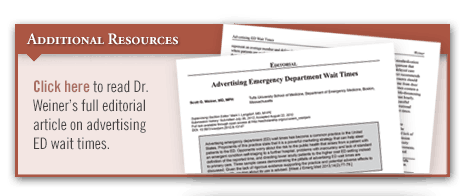Throughout the country, many hospitals are advertising their services to the public using various marketing vehicles. Many of these advertisements prominently display ED wait times as a major selling point, suggesting that their wait times are short and convenient. Proponents of this practice say this is a powerful marketing strategy that can help steer patients to the ED, thus potentially increasing hospital revenue. This practice may also alleviate some of the burden on other hospitals because patients with less severe problems may opt to drive a little farther to a different hospital if they think the wait time will be shorter.
Wait Times May Be Potentially Misleading
Although there are potential gains for advertising ED wait times, it’s also important to recognize that this practice can be misleading. There are no clear standards on what advertised times represent. For example, it’s unknown at what point the clock starts and when it stops. Advertised wait times are merely an average number, but this can defeat the purpose of triage. ED patients are supposed to be evaluated based on the time-sensitivity of their condition rather than the order upon which they arrive. For laypeople, this fact may not be clear when they see an advertisement.
The numbers on advertising wait times also don’t account for patients who need to be transferred or have care deferred to a follow-up visit with a specialist. Other factors may prolong wait times, especially if there are laboratory or radiology inefficiencies. These numbers also don’t describe the times that admitted patients may need to wait if there is a lack of available inpatient beds. Furthermore, advertising wait times changes the emphasis for clinicians to reducing initial door to first evaluation times rather than on more meaningful markers, such as time to admission or discharge.
Formal Initiatives Needed
Currently, there are no formal guidelines for advertising ED wait times. Several key obstacles must be considered, including a dearth of available evidence, the lack of standardization of defining reported wait times, and the fact that patients with emergent conditions may have delayed care. Until more evidence emerges, advertisements should consider displaying wait times that are defined as “time from door to qualified medical provider time.” Wait times should also have a disclaimer indicating that these times do not apply to potentially life-threatening conditions. Importantly, any such initiative should also be conducted collaboratively with hospital-wide initiatives that address institutional operational inefficiencies. Pending more evidence, caution should be used whenever hospitals are considering advertising their ED wait times.




 admin
admin